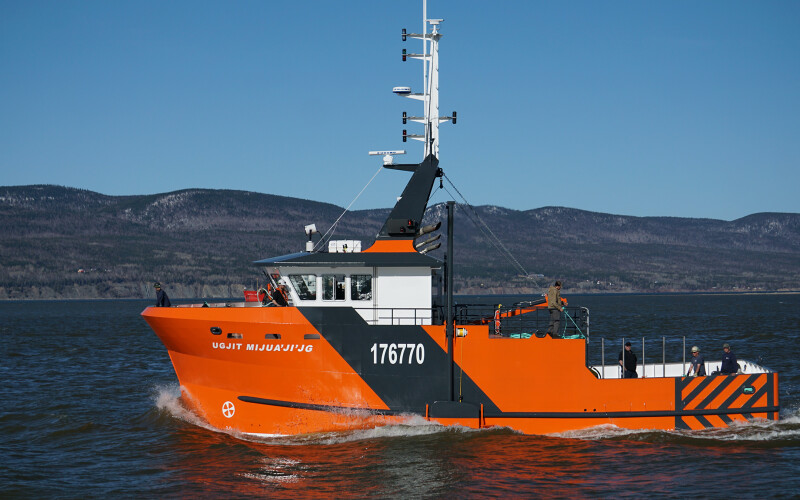With an active fleet of nine boats, the Listuguj Mi’gmaq Government in Quebec has a big investment in snow crab, and in May of 2022, it accepted delivery of a crabber trawler that will increase efficiency and reduce the environmental impacts of crabbing and fishing operations. The Listuguj Mi’gmaq Government christened the new boat, the Ugjit Mijua’ji’jg, which means “for the children” in the Mi’gmaq language.
“The Listuguj Mi’gmaq Government wants to retire some of its older boats,” says Jean-Nil Morissette, partner in Chantier Naval Forillon, and Navanex, the builder and designer of the vessel, respectively. “So they are upgrading to a bigger boat with more capacity.”
Central to the vessel’s power and environmental profile is the Cummins main with selective catalytic reduction (SCR) after treatment for engine emissions.
“It’s a Cummins QSK19 producing 750 hp at 1800 rpm,” Morissette said. “To meet the IMO tier III emissions, the QSK19 main engine is fitted with a proven SCR catalyst.”
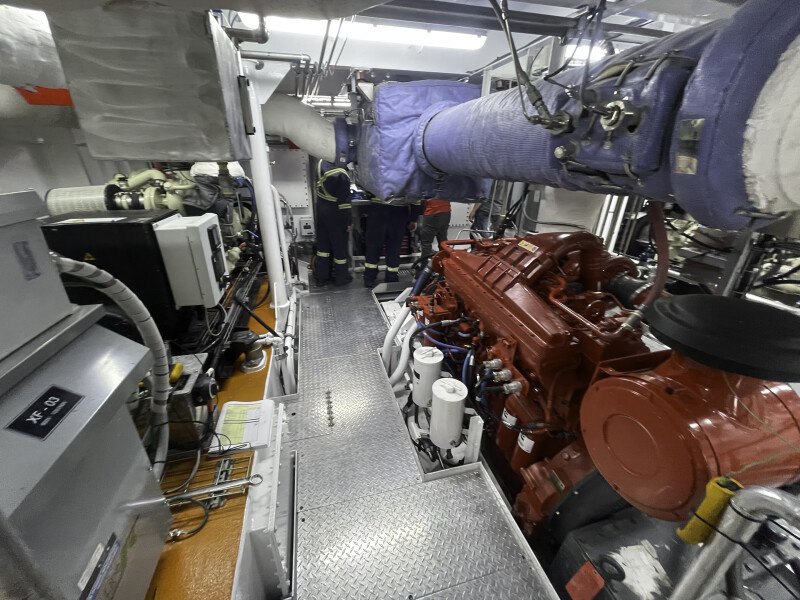
Morissette points out that the system achieves a 93 percent reduction in NOX and increases engine efficiency. “The way it works is when we follow the rules for IMO Tier 2, it’s a compromise between NOX and CO2. When you run the engine efficiently, it increases NOX, but when you reduce NOX, you increase CO2. When you use the DEF (diesel exhaust fluid) after-treatment, you can reduce the NOX and the CO2 and increase engine performance.”
According to Diesel Tech Forum, in an SCR scrubber “hot exhaust gases flow out of the engine and into the SCR system where DEF with aqueous urea is sprayed onto a special catalyst. The DEF sets off a chemical reaction in the exhaust that converts nitrogen oxides into nitrogen, water, and tiny amounts of carbon dioxide (CO2). The high efficiency of SCR systems in reducing NOx emissions allows manufacturers to balance engine performance and maximize fuel economy while still achieving near zero emissions.”
The drawbacks of the system are the space requirements. “That’s the job of the naval architect,” says Morissette. “We have to find a way to fit everything in the available space. The scrubber takes up space in the engine room, and the amount of DEF fluid should be 10 percent of the fuel,” says Morissette. “The fuel capacity is 23,000 liters (6,075 gallons), and the DEF is 1,800 liters (475 gallons).”
Morissette and the team at Navanex designed a 65-foot vessel with a 24-foot beam and a 12.5-foot draft when loaded. In addition to the main engine, the IMO Tier III system, below deck, the vessel has auxiliary power from a 65kW QSB7-DM genset, and a 355-hp Cummins QSM11-DM engine, tankage for fuel, DEF, and water and still has room for 50,000 pounds of crab in four refrigerated seawater (RSW) tanks.
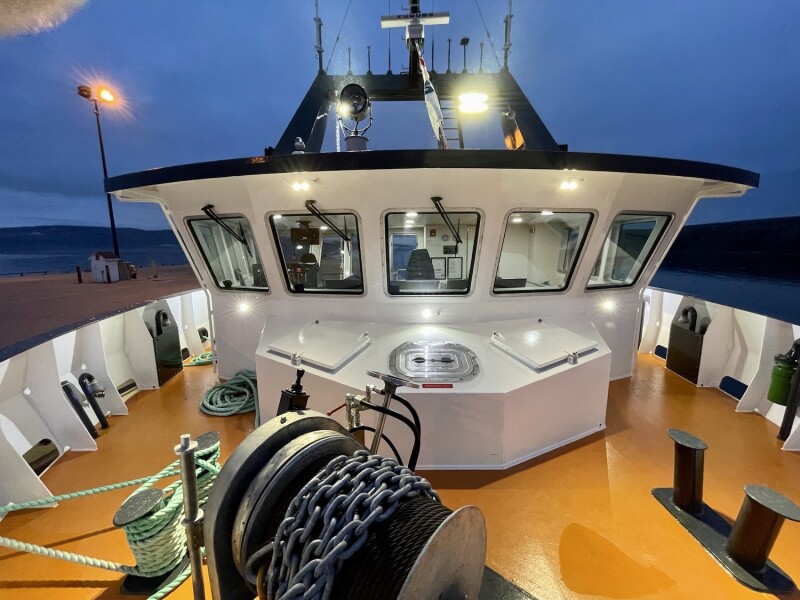
Another challenge in the design of the vessel comes from the Listuguj Mi’gmaq Government’s desire also to use the vessel as a trawler. “We built an afterdeck behind the wheelhouse for a trawl winch on the starboard side,” says Morissette. “For the port side winch, there is decking over the wet locker,” he adds, noting the extension of the deck level house on the port side that will be used for crew gear.
“That decking has extra support, and we have all the hydraulic line ready for when they put the winches on,” says Morissette. “They also have a gantry and net reel for the trawling.”
Morissette notes, however, that the winches, net reel, and gantry are still in the design process. “The winches and net drum are not made yet, but if required, we can make and install those,” he says.
But Morissette notes that the hydraulics to support the trawling option require higher capacity hydraulic pumps and volume. “When you’re crabbing, it’s only the pot hauler, but the winches have a lot of pull, so we need more power. We need more than twice the capacity of the hydraulic system for the trawling gear compared to the crab fishing pot hauler and then a bit more for the bow thruster,” he says. “The Cummins QSM11-DM will power the hydraulics. We have the pump on one end, and on the other end is a backup 65kW generator.”
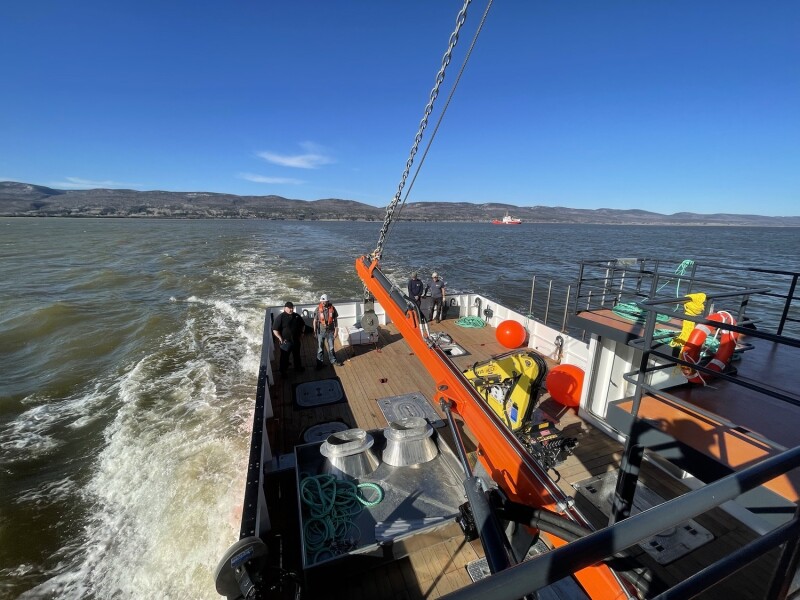
Running the 20-ton electric RSW system is one of the important roles of the gensets. “The RSW system comes from Nordic Refrigeration in Caraquet, New Brunswick,” says Morissette. Nordic Refrigeration Ltd was founded in 1979 by the owner, Paul Lanteigne. According to the company website, Nordic Refrigeration Ltd specialized in marine refrigeration for fishing vessels from the start, along with other land-based applications. Morissette points out that Nordic does nearly all of Chantier Naval Forillon’s refrigeration work.
Deck equipment includes a Heila HLM 3-2S deck crane, which has a 22-foot range and can lift anywhere from 1,000 to 4,000 pounds depending on the extension and angle. “They use a different kind of trap than in Alaska,” says Morissette. “They are collapsible, and there is space to stack 150 traps on deck using the crane.” On the starboard rail a hydraulic hauler will bring traps through a block on a maneuverable boom. “The boom is our design,” says Morissette. “It has another hydraulic 4-foot extension on the end, and it swings the traps in. They dump the crab onto the sorting table that they can raise to an ergonomic level. They put the crab down chutes that take them to the RSW.”
The new vessel has accommodations for six people, and according to Morissette, the crew will be all Native. “They may stay out for a few days,” he says.
The modernization of the Listuguj fleet continues in the wheelhouse of the Ugjit Mijua’ji’jg. “Electronics include Time Zero, Navnet 2 Touch, Furuno radars and autopilot, a Koden sounder, and more,” says Morissette. “There is a station in the middle for trawling and steaming and another station aft on the starboard side for crabbing.”
When crabbing, the vessel has to be maneuverable. The 750-hp Cummins main has a Twin Disc MGX-5222 gear with 5.04:1 reduction, which will turn a four-blade Rice Kaplan Skewed propeller with a 57-inch diameter and a 67-inch pitch. A nozzle adds additional power. In spite of its deep draft and bulbous bow, Morissette reports that the Ugjit Mijua’ji’jg can make the quick turns needed to get on gear. “In our sea trials, we found it can turn within three boat lengths,” he says of the vessel.
The maneuverability is more complicated by the hull’s stabilizers. Like many boats in the area, the Ugjit Mijua’ji’jg has hydraulic wing stabilizers. The wing stabilizers extend from the hull just forward of the middle and just below the water line. They can be raised up when needed. “Some captains use only the port side stabilizer when they are fishing,” says Morissette, duly noting that the starboard stabilizer could foul with a crab pot buoy. “But other captains like to make a quick turn when they get close to the buoy.”
Chantier Naval Forillon completed the vessel at its yard in Gaspé and delivered it 14 months after signing the contract. “We spent 2 or 3 months on design, and then 10 or 12 on building,” says Morissette, who works in both the design and construction arms of the company.
According to Morissette, the Chantier Naval Forillon yard has a dry dock that can accommodate vessels up to 180 feet in length, 34 feet in breadth, and with an 18-foot draft. “Inside we can build a boat up to 150 feet and 34 feet wide,” says Morissette. “We can build up to 38 feet high. Of course, we don’t put on the mast inside.” Regarding the mast, Morissette points out that the mast of the Ugjit Mijua’ji’jg is specifically designed to shed ice. “In these waters, ice can be a problem,” says Morissette. “And there are specific calculations and criteria for ice accumulation that we have to meet.”
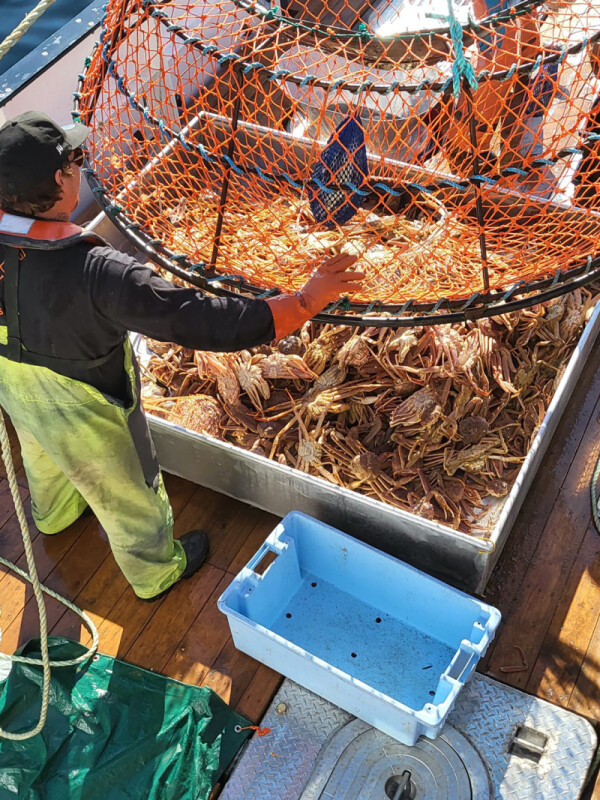
The Ugjit Mijua’ji’jg made it into the water in time for the 2022 season and performed well. But Morissette, who is among the four partners who bought the company in 2018, has bigger plans.
“We would like to sell the design in the U.S.,” he says. “We know there are problems with the Jones Act, but if we can, we’d like to find a yard we can work with on our design.”
Whether that happens remains to be seen, but the vessel is the third boat that Chantier Naval Forillon has built for the Listuguj Mi’gmaq Government, with more likely to come.





